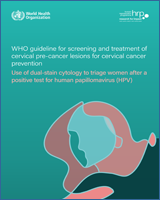Cervical intraepithelial neoplasia (CIN) is a premalignant lesion that may exist at any one of three stages: CIN1, CIN2, or CIN3. If left untreated, CIN2 or CIN3 (collectively referred to as CIN2+) can progress to cervical cancer. Instead of screening and diagnosis by the standard sequence of cytology, colposcopy, biopsy, and histological confirmation of CIN, an alternative method is to use a ‘screen-and-treat’ approach in which the treatment decision is based on a screening test and treatment is provided soon or, ideally, immediately after a positive screening test. Available screening tests include a human papillomavirus (HPV) test, visual inspection with acetic acid (VIA), and cytology (Pap test). Available treatments include cryotherapy, large loop excision of the transformation zone (LEEP/LLETZ), and cold knife conization (CKC).
This guideline provides recommendations for strategies for a screen-and-treat programme. It builds upon the existing WHO guidelines: Use of cryotherapy for cervical intraepithelial neoplasia (published in 2011) and on the new WHO guidelines for treatment of cervical intraepithelial neoplasia 2–3 and glandular adenocarcinoma in situ (being published concomitantly with these present guidelines). This guideline is intended primarily for policy-makers, managers, programme officers, and other professionals in the health sector who have responsibility for choosing strategies for cervical cancer prevention, at country, regional and district levels.
For countries where a cervical cancer prevention and control programme already exists, these recommendations were developed to assist decision-makers to determine whether to provide a different screening test followed by a different treatment, or to provide a series of tests followed by an adequate treatment. For countries where such a programme does not currently exist, these recommendations can be used to determine which screening test and treatment to provide. In addition to the recommendations, a decision-making flowchart is also proposed in Annex 2 to help programme managers choose the right strategy based on the specific country or regional context. Once the strategy has been chosen, the appropriate screen-and-treat flowchart for that strategy can be followed. The flowcharts for all strategies are provided in Annex 3 (specifically for women of negative or unknown HIV status), and Annex 4 (for women of HIV-positive status or unknown HIV status in areas with high endemic HIV infection).
The methods used to develop these guidelines follow the WHO handbook for guideline development, and are described in Chapter 2 of this document. A Guideline Development Group (GDG) was established that included experts, clinicians, researchers in cervical cancer prevention and treatment, health programme directors and methodologists. Conflicts of interest were managed according to World Health Organization (WHO) rules. An independent group of scientists at a WHO collaborating centre conducted systematic reviews on the diagnostic accuracy of the available screening tests and the effects of different treatments for CIN (see Annexes 5–7). This evidence was used to model and compare different screen-and-treat strategies in women of unknown HIV status and women of HIV-positive and HIV-negative status and the results were presented to the GDG in evidence tables following the GRADE (Grading of Recommendations, Assessment, Development and Evaluation) approach. The GRADE evidence profiles and evidence-to-recommendation tables for each recommendation are available online (Supplemental material, Sections A and B).
This guideline provides nine recommendations for screen-and-treat strategies to prevent cervical cancer. While a brief summary of the recommendations is included on the next page, the complete recommendations with remarks and a summary of the evidence for each are found in Chapter 3 of this document.
Although the best evidence to assess the effects of a screen-and-treat strategy is from randomized controlled trials, we identified few randomized controlled trials that evaluated these strategies and reported on patient-important outcomes. Areas for future research include screen-and-treat strategies using a sequence of tests (e.g. HPV test followed by VIA); screen-and-treat strategies in women of HIV-positive status; and measurement of important health outcomes following a screen-and-treat strategy.
